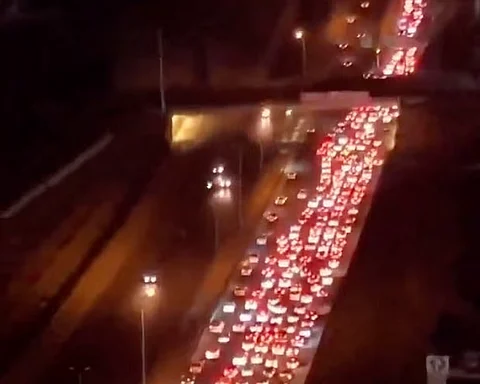

Israel’s war against Iran appeared to be reaching a decisive juncture on Tuesday night, following five days of intense bombardment and Iranian retaliatory strikes, as US President Donald Trump demanded Tehran’s “unconditional surrender” and weighed direct military involvement.
Trump gathered his national security team on Tuesday after a day of erratic messaging. Earlier, he told reporters he expected Iran’s nuclear programme to be “wiped out” without US intervention, but later suggested via Truth Social that Iran's supreme leader Ayatollah Ali Khamenei was a potential target, posting: “We know exactly where the so-called ‘Supreme Leader’ is hiding... He is an easy target... but we don’t want missiles shot at civilians or American soldiers. Our patience is wearing thin.”
Minutes later, he posted in all caps: “UNCONDITIONAL SURRENDER.”
While Trump’s online threats heightened speculation of US military involvement, they were compounded by the sudden forward deployment of US aircraft to Europe and the Middle East. Many believe that only the US possesses the bunker-busting capability required to destroy Iran’s deeply buried nuclear facilities.
German Chancellor Friedrich Merz, fresh from G7 talks with Trump in Canada, told ZDF television: “If Iran does not back down, destruction of its nuclear programme is inevitable—and Israel cannot do it alone.”
French President Emmanuel Macron, by contrast, urged restraint: “The worst mistake now would be to pursue regime change through military means—it would plunge the region into chaos.”
Trump departed the summit early, flying back to Washington late Monday. Speaking to journalists en route, he rejected the idea of a ceasefire, instead calling for a “complete give-up” by Iran and a total halt to uranium enrichment.
US vice-president JD Vance echoed that tone, posting: “He may decide he needs to take further action to end Iranian enrichment... but people are right to be wary of foreign entanglements after 25 years of idiotic policy.”
Trump predicted Israel would press on, suggesting that a decisive phase was imminent: “You’re going to find out over the next two days... Nobody’s slowed up so far.”
Yet doubts about Israel’s justification for launching the war emerged on Tuesday when CNN cited US intelligence suggesting Iran was still “up to three years” from being able to build and deliver a nuclear weapon. That echoed testimony from Trump’s own intelligence chief, Tulsi Gabbard, who told Congress in March that Iran was not actively building a bomb and that Khamenei had not re-authorised the suspended nuclear weapons programme.
Asked about Gabbard’s assessment, Trump replied: “I don’t care what she said—I think they were very close.”
Speaking aboard Air Force One, he warned that any Iranian attack on American troops or interests would meet overwhelming retaliation: “We’ll come down so hard, it’d be gloves off.”
Iran’s foreign minister, Abbas Araghchi, said Tehran remained open to diplomacy. “If President Trump is genuine, the next steps will be consequential,” he said.
In Israel, Prime Minister Benjamin Netanyahu dismissed the idea of renewed talks: “Of course they want to stop—and continue building tools of death. We gave that a chance.”
Netanyahu laid out expanded war aims: dismantling Iran’s nuclear programme, ending its ballistic missile capabilities, and destroying its so-called “axis of terror”. His foreign minister, Gideon Sa’ar, later clarified: “We are targeting the head of the octopus. Hamas and Hezbollah were the tentacles. Now we’re going after the source.”
Israel’s targeting has escalated accordingly. Airstrikes have hit Tehran directly, including an evacuation order for a northern district of the city affecting over 3,00,000 people. One strike destroyed a state television station, killing three staff members. Israel has also attacked oil and gas infrastructure, while Iran has retaliated with strikes on Haifa, damaging a refinery and a power plant.
Iran’s health ministry reported that Israeli strikes had killed at least 224 people and injured over 1,400 since Friday. On Tuesday alone, 24 people were killed. Iranian missiles hit Israel early Tuesday, wounding five people. Israel’s death toll stood at 24, with some 600 injured.
The Israel Defence Forces (IDF) claimed Iran had launched 370 missiles across eight barrages—about 12 percent of its estimated 3,000-missile arsenal—and that 200 Iranian launchers had been destroyed. The IDF also reported the killing of 11 Iranian generals, including Maj Gen Ali Shadmani, acting armed forces commander, who had held the post for just four days.
An IDF officer told Israeli media: “Iran is completely exposed. We have full freedom of action.”
Despite Tehran’s threats to evacuate Haifa and Tel Aviv, many observers believe Iran has few strategic options left. Lawmakers in Tehran have drafted a bill to withdraw from the 1968 Nuclear Non-Proliferation Treaty, though officials maintain Iran opposes weapons of mass destruction.
Hardliners have also called for closing the Strait of Hormuz, through which over 17 million barrels of oil pass daily—an act that could send global oil prices soaring.
The International Atomic Energy Agency confirmed on Tuesday that Israeli strikes had breached underground levels of the Natanz enrichment facility. But the Fordow site near Qom—home to Iran’s 60 percent enriched uranium stockpile—remains untouched.
Kelsey Davenport of the Arms Control Association said Fordow’s destruction might release limited radiation but is unlikely to factor into military decisions. “Israel knows it cannot destroy the site,” she said.